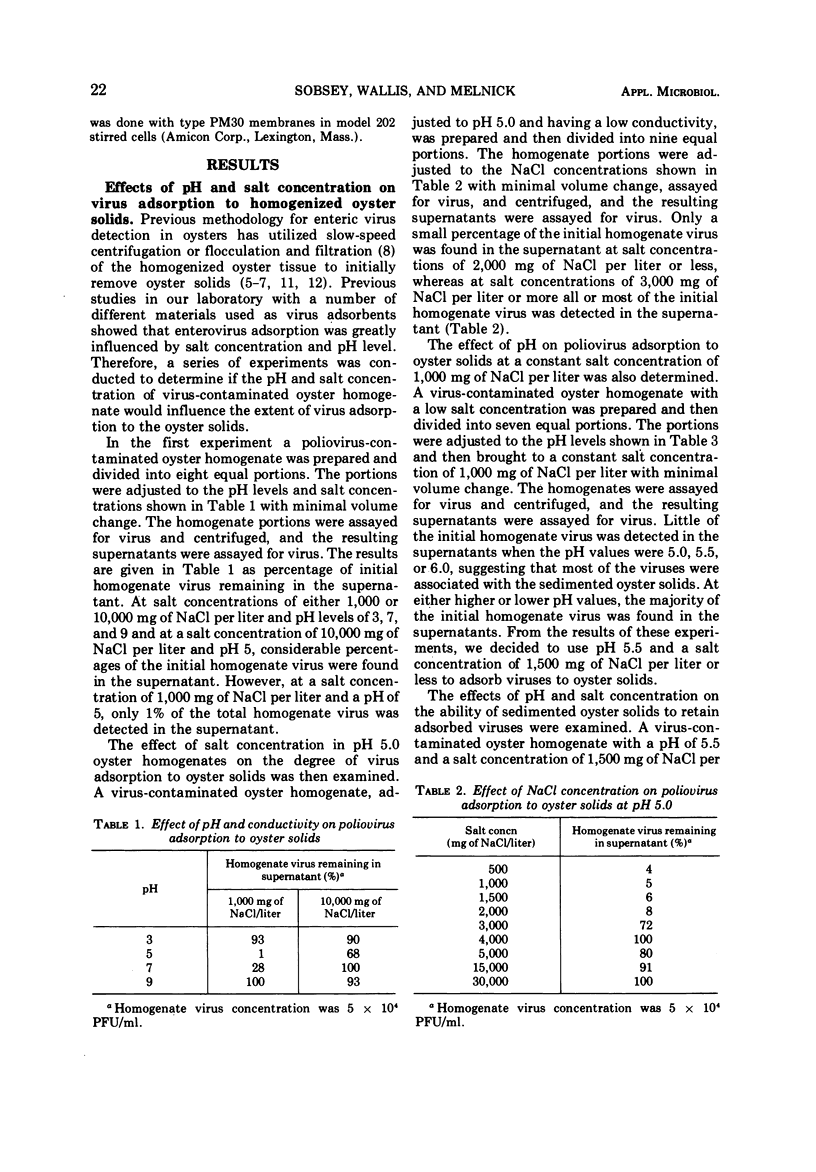Abstract
The development of a simple method for concentrating enteroviruses from oysters is described. In this method viruses in homogenized oyster tissues are efficiently adsorbed to oyster solids at pH 5.5 and low salt concentration. After low-speed centrifugation, the supernatant is discarded and viruses are eluted from the sedimented oyster solids by resuspending them in pH 3.5 glycine-buffered saline. The solids are then removed by low-speed centrifugation, and the virus-containing supernatant is filtered through a 0.2-μm porosity filter to remove bacteria and other small particulates without removing viruses. The virus-containing filtrate is then concentrated to a volume of a few milliliters by ultrafiltration, and the concentrate obtained is inoculated directly into cell cultures for virus assay. When tested with pools of oysters experimentally contaminated with small amounts of different enteroviruses, virus recovery efficiency averaged 63%.
Full text
PDF





Selected References
These references are in PubMed. This may not be the complete list of references from this article.
- Guskey L. E., Wolff D. A. Concentration and purification of poliovirus by ultrafiltration and isopycnic centrifugation. Appl Microbiol. 1972 Jul;24(1):13–17. doi: 10.1128/am.24.1.13-17.1972. [DOI] [PMC free article] [PubMed] [Google Scholar]
- Hamblet F. E., Hill W. F., Jr, Akin E. W., Benton W. H. Oysters and human viruses: effect of seawater turbidity on poliovirus uptake and elimination. Am J Epidemiol. 1969 May;89(5):562–571. doi: 10.1093/oxfordjournals.aje.a120969. [DOI] [PubMed] [Google Scholar]
- Herrmann J. E., Cliver D. O. Methods for detecting food-borne enteroviruses. Appl Microbiol. 1968 Oct;16(10):1564–1569. doi: 10.1128/am.16.10.1564-1569.1968. [DOI] [PMC free article] [PubMed] [Google Scholar]
- Konowalchuk J., Speirs J. I. Enterovirus recovery from laboratory-contaminated samples of shellfish. Can J Microbiol. 1972 Jul;18(7):1023–1029. doi: 10.1139/m72-159. [DOI] [PubMed] [Google Scholar]
- Kostenbader K. D., Jr, Cliver D. O. Polyelectrolyte flocculation as an aid to recovery of enteroviruses from oysters. Appl Microbiol. 1972 Oct;24(4):540–543. doi: 10.1128/am.24.4.540-543.1972. [DOI] [PMC free article] [PubMed] [Google Scholar]
- METCALF T. G., STILES W. C. THE ACCUMULATION OF ENTERIC VIRUSES BY THE OYSTER, CRASSOSTREA VIRGINICA. J Infect Dis. 1965 Feb;115:68–76. doi: 10.1093/infdis/115.1.68. [DOI] [PubMed] [Google Scholar]
- Mitchell J. R., Presnell M. W., Akin E. W., Cummins J. M., Liu O. C. Accumulation and elimination of poliovirus by the eastern oyster. Am J Epidemiol. 1966 Jul;84(1):40–50. doi: 10.1093/oxfordjournals.aje.a120626. [DOI] [PubMed] [Google Scholar]
- Sobsey M. D., Wallis C., Henderson M., Melnick J. L. Concentration of enteroviruses from large volumes of water. Appl Microbiol. 1973 Oct;26(4):529–534. doi: 10.1128/am.26.4.529-534.1973. [DOI] [PMC free article] [PubMed] [Google Scholar]
- Wallis C., Melnick J. L. Concentration of enteroviruses on membrane filters. J Virol. 1967 Jun;1(3):472–477. doi: 10.1128/jvi.1.3.472-477.1967. [DOI] [PMC free article] [PubMed] [Google Scholar]
- Wallis C., Melnick J. L. Concentration of viruses from sewage by adsorption on millipore membranes. Bull World Health Organ. 1967;36(2):219–225. [PMC free article] [PubMed] [Google Scholar]


